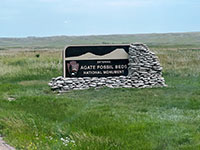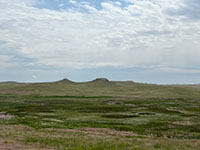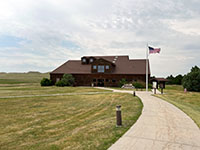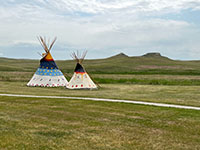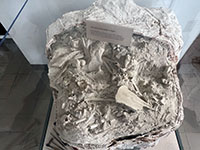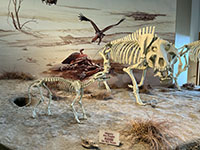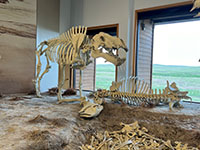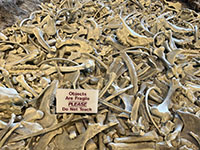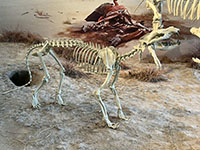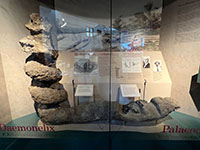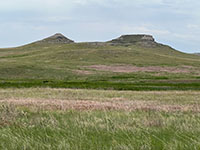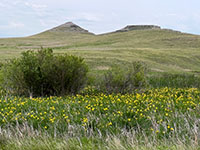
Agate Fossil Beds National Monument, Nebraska
Click On Images For A Larger View. |
Return to Geology of National Parks main page |
| Fossils were discovered in the vicinity as far back as 1878, but Agate Fossil Beds National Monument in northwestern Nebraska wasn't established until 1965. Today it is both paleontological preserve and an ecological preserve for the local short-grass prarie along the headwaters of of the Niobrara River. The park is host to scenic outcrop of Miocene sedimentary layers where bone beds of vertebrate fossils were mined bymuseums and paleontological museums. Many fossils are now on display in the park's Visitor Center museum. Learn more about the geology and paleontology of the park at these NPS websites: Geology At Agate Fossil Beds NPS Geodiversity Atlas—Agate Fossil Beds National Monument, Nebraska. |
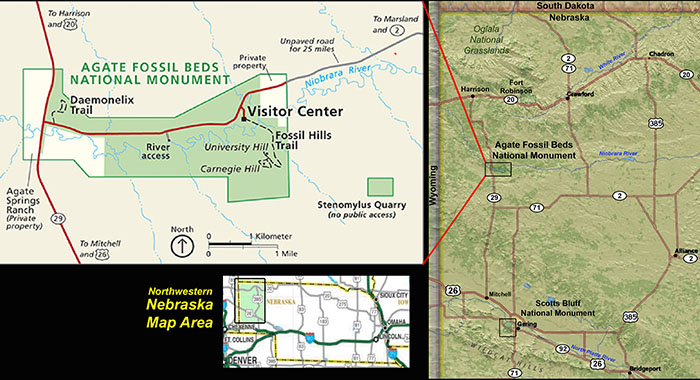
Map of Agate Fossil Beds National Monument in northwestern Nebraska. (Click on map for a larger view.) |
Selected Views of Agate Fossil Beds National MonumentThe images below partly illustrate the experience of visiting Agate Fossil Beds National Monument. The very rural location of the park requires taking one of the most scenic drives in the country (especially if you like to watch weather and potential wildlife sightings on the short-grass prairie.Figure 1 shows the sign at the park entrance. Figure 2 shows an outcrop near a parking area at the park entrance. Displays at the parking area describe the local geology and history of exploration of fossil beds preserved in local sedimentary deposits of sandstone, limestone, and volcanic ash beds where fossils were preserved. Most of the bone beds probably associated with ancient watering holes where animals gathered and died from being smothered by volcanic ash clouds from massive volcanic eruptions as far away as where Nevada is today. Figure 3 illustrates that the park is also an ecological preserve for the short-grass prairie, wetlands, and raparian forest habitats along the Niobrara River valley. Figure 4 shows the park's Visitor Center with its museum. Figure 5 shows a couple tepees on display near the Visitor Center. The museum's displays focus on the paleontological, archaeological, and cultural history of the park area. Figures 6 through 12 illustrate some of the paleontological exhibits on display in the museum. Perhaps thousands of fossils were collected in the park area and added to displays and fossil collections in museums around the country (see list below). The Visitor Center has examples of the fossils collected with descriptions and interpretation of how and why the Miocene-age fossils were preserved from the park area (see the NPS website links above to learn more about the geology and paleontology of the park). Figures 13 to 16 illustrate the scenic landscape (prairie, wetlands, and bluffs) along the Niobrara River Valley. A hiking trail that starts at the Visitor Center leads across the stream valley to the buttes in the disance where a couple of the historic fossil quarries are located. |
| See this NPS website "Agate Bonebed" to see how fossils were collected, prepared, studied, and preserved. Some of the institutions with fossil collects and displays from Agate Fossil Beds include: Trailside Museum at Fort Robinson State Park in Nebraska Museum of Geology at the South Dakota School of Mines and Technology in Rapid City, South Dakota Geological Museum at the University of Wyoming in Laramie, Wyoming University of Nebraska State Museum in Lincoln, Nebraska Field Museum of Natural History in Chicago, Illinois University of Michigan Exhibit Museum in Ann Arbor, Michigan Carnegie Museum in Pittsburgh, Pennsylvania American Museum of Natural History in New York, New York Museum of Comparative Zoology in Cambridge, Massachusetts Joe Webb Peoples Museum of Natural History at Wesleyan University in Middletown, Connecticut |
| >This page is <https://gotbooks.miracosta.edu/gonp/agfo/> Last modified 7/22/2024. |
